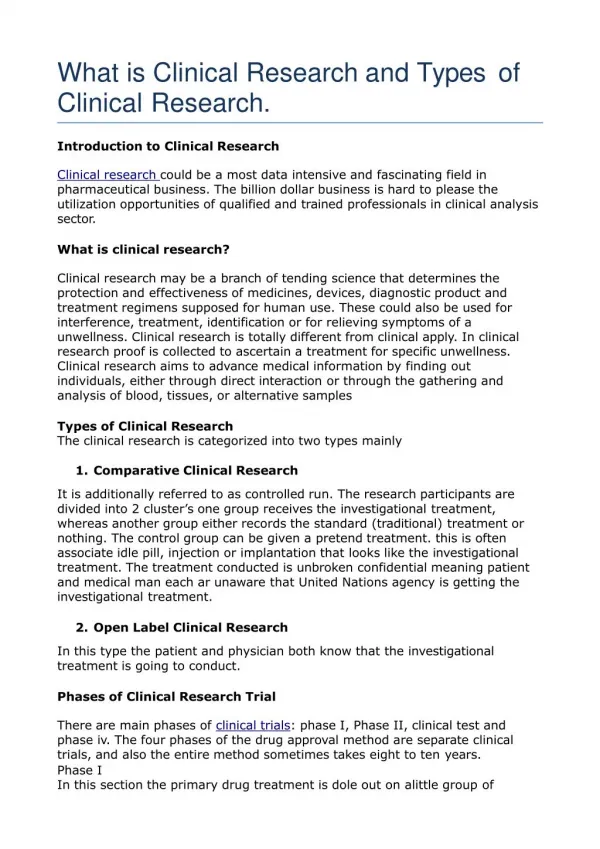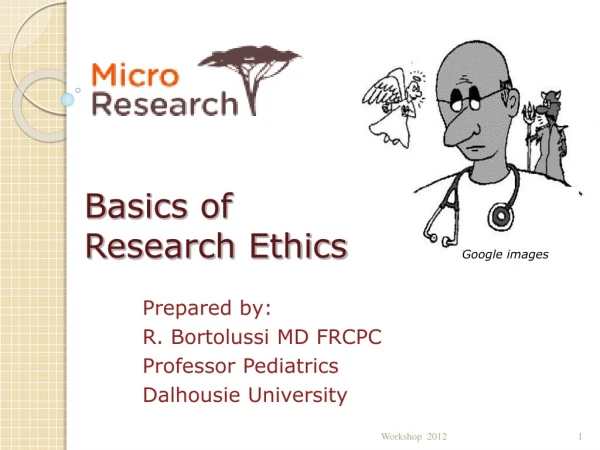

Basics of Clinical Research
Mar 21, 2019
550 likes | 965 Views
Basics of Clinical Research. Beth Elinoff, RN, MPH, CCRC Human Immunology Research Coordinator. What is Clinical Research/ Human Subject Research?. Department of Health and Human Services (DHHS) Definitions (45 CFR 46.102): 1. Human Subject Research
Share Presentation
- clinical practice
- informed consent
- nuremberg code
- good clinical practices
- therapeutic human subject research

Presentation Transcript
Basics of Clinical Research Beth Elinoff, RN, MPH, CCRC Human Immunology Research Coordinator
What is Clinical Research/Human Subject Research? Department of Health and Human Services (DHHS) Definitions (45 CFR 46.102): • 1. Human Subject Research In order for activities to be deemed “Human Subject Research” by the DHHS, they must meet the definition of “research” and involve one or more “human subjects” as defined by DHHS regulations.
DHHS Definitions (con’t) • A. Research “A systematic investigation, including research development, testing and evaluation, designed to develop or contribute to generalizable knowledge.” • Belmont Report Definition of Research “Any activity designed to test a hypothesis, permit conclusions to be drawn and thereby to develop or contribute to generalizable knowledge (expressed, for example, in theories, principles, and statements of relationships).”
DHHS Definitions (con’t) • B. Human Subjects: “A living individual about whom an investigator conducting research obtains (1) data through intervention or interaction with the individual; or (2) identifiable private information.”
DHHS Definitions (con’t) • Intervention: Includes both the physical procedures by which data are gathered (eg. blood draw) and manipulations of the subject or the subject’s environment that are performed for research purposes • Interaction: Includes communication or interpersonal contact (eg. questionnaires, interviews) between the investigator and subject
DHHS Definitions (con’t) • Private Information: Includes information about behavior that occurs in a context in which an individual can reasonably expect that no observation or recording is taking place, and information which has been provided for specific purposes by an individual and which the individual can reasonably expect will not be made public (eg. medical record). Private information must be individually identifiable (eg. the identity of the subject is or may readily be ascertained by the investigator or associated with the information).
Food and Drug Administration (FDA) Definition of Human Subject Research • FDA has different definitions of “research” and “human subjects” • FDA guidelines must be followed when using a drug or device in the study
History of Development of Human Research Protections • Public Health Service Syphilis Study ’32-’71 • Better known as the “Tuskeegee Syphilis Study” • Originally designed to make treatment available to African-American men with syphilis, even though there was no known effective treatment • Issues: • Men were recruited without their consent • Misinformation about procedures, ie spinal taps • After penicillin was proven an effective treatment ’40’s), men were denied antibiotics and prevented treatment from military and local physicians
History of Development of Human Research Protections • US Food, Drug and Safety Act (1938) • 107 people died after taking sulfanilamide, a cold remedy that contained anti-freeze. • This act enforces manufacturers to demonstrate drug safety.
History of Development of Human Research Protections • Nuremberg Code (1947) • Result of the trial of Nazi doctors and scientists from WWII – no guidelines for human research • Guidelines: • Need for informed consent • Research should be based on prior animal work • Risks should be justified by anticipated benefits • Only qualified scientists must conduct research • Physical and mental suffering must be avoided • No research where death/severe injury is expected
History of Development of Human Research Protections • Nuremberg Code (con’t) • Problems: • Little impact on research done in the US – thought to condemn Nazis • No strength of the law behind it • Only applied to non-therapeutic human subject research
History of Development of Human Research Protections • Declaration of Helsinki (1964) • Code of ethics developed by the World Medical Association (now known and World Health Org) • Broader than Nuremberg Code • Geared towards therapeutic medical research • Recommended informed consent • Precursor to IRB requirement • Journals required all published research to follow Declaration’s guidelines
History of Development of Human Research Protections • The National Research Act (1974) • Culmination of hearings by US Congress established the National Commission for the Protection of Human Subjects of Biomedical and Behavioral Research • Purpose of The National Commission: • Identify basic ethical principles underlying the conduct of human subject research • Develop guidelines to ensure conduct of human subject research in accordance with those principles
History of Development of Human Research Protections • The National Research Act (con’t) • 45 CFR 46 – “Regulations for the Protection of Human Subjects of Biomedical and Behavioral Research”; Issued by the Department of Health, Education and Welfare (later renamed DHHS) • Revisions made in late 1970’s and early 1980’s • By 1991, 16 other federal agencies/departments applied 45 CFR 46 to research they fund/conduct • Referred to as the “Common Rule”
History of Development of Human Research Protections • The Belmont Report (1979) • Issued by the National Commission for the Protection of Human Subjects of Biomedical and Behavioral Research • Purpose: resolve ethical problems that surround the conduct of human subject research • One principle does not outweigh another; each has equal weight
History of Development of Human Research Protections • The Belmont Report (con’t) The three principles: • Respect for Persons – treat people as autonomous creatures and not a means to an end; provide extra protection for those with limited autonomy • Requires informed consent • Requires respect of privacy of research subjects
History of Development of Human Research Protections • The Belmont Report (con’t) The three principles: • Beneficence – minimize harm and maximize benefit • Requires use of the best possible research design to maximize benefit and minimize harm • Requires researchers to be able to perform the procedures and manage the risks • Prohibits research without a favorable risk-benefit ratio
History of Development of Human Research Protections • The Belmont Report (con’t) The three principles: • Justice – treat all people fairly and ensure burdens and benefits are shared equitably • Requires equitable selection of research subjects • Requires avoidance of exploitation of vulnerable populations or populations of convenience (ie pregnant women; children; incarcerated populations)
History of Development of Human Research Protections • International Conference on Harmonisation - ICH (1990) • Joint regulatory/industry project to improve process of developing new products between Japan, Europe and United States • Allows for international research studies to follow same rules/regulations • Conference convenes to update regulations • Established “Good Clinical Practices”
Good Clinical Practices • Known as GCP’s • Misnomer – they are rules/regulations for the conduct of research • Sometimes called “Good Research Practices” • Standard for the design, conduct, performance, monitoring, analyses and reporting of research • Even though established for drug studies, they dictate appropriate conduct for all research
Innovative Practice vs. Research • Innovative clinical practice is an intervention designed solely to enhance the well-being of an individual patient or client. The purpose is to provide diagnosis, preventative treatment, or therapy to particular individuals. • Considered “research” only if previous criteria is met. • At UPMC, the introduction of innovative procedures or therapies into clinical practice (when research is not involved), requires review by department chair and the UPMC Technology Assessment Committee/Innovative Practices Sub-Committee prior to implementation.
Quality Assurance vs. Research • Precise definitions to permit the distinction between research studies and quality assurance projects are difficult and have not been established. In general, a quality assurance project is a project that is focused primarily on improving patient care within a given patient care environment and, as such, the outcome may not be generalizable to other patient care environments. • Both UPMC and CHP require the submission of all quality assurance projects for review.
Questions to distinguish QA from Research(any yes response indicates research) • Is there a commitment, in advance of data collection, to a corrective plan given any one of a number of study outcomes? Does the PI of the study have both clinical supervisory responsibility and the authority to impose change? • Is the research being sponsored/funded by an external agency? • Does the proposed study involve the prospective assignment of patients to different procedures or therapies based on a predetermined plan? • Does the proposed study involve a “control group” in whom the therapeutic or study intervention is intentionally withheld to allow an assessment of its efficacy?
Questions to distinguish QA from Research • Will the study intervention be delivered in a blinded fashion wherein neither the physician nor the patient knows to whom the study intervention or comparative intervention (eg. standard care, placebo) was given? • Is the assessment of outcome blinded to the study intervention for purpose of establishing the efficacy of the intervention? • Does the proposed study involve the prospective evaluation of a drug, biologic or device that is not currently approved for general use by the FDA? • Will patients involved in the proposed study be exposed to additional risks or burdens beyond standard clinical practice in order to make the results of the study generalizable?
Types of Study Designs • Observational Designs
Types of Observational Studies • Cohort Studies • A group of subjects followed over time • Purpose: defining the incidence and investigating potential causes of a condition (incidence) • Can be prospective – investigator chooses a sample group and measures characteristics in each subject over a period of time that might predict outcomes • Can be retrospective – same as prospective, except all data collection and follow-up has happened in the past; only possible if adequate data is available
Types of Observational Studies • Cross-Sectional Studies • Similar to cohort studies except all the measurements are made at one time point with no follow-up • Purpose: describing variables and their distribution patterns (prevalence) • Strength – fast and inexpensive since there is no follow-up or waiting time for outcome
Types of Observational Studies • Case-Control Studies • Two groups of people examined for the same outcome • Group 1 – “cases” or a population of people with a certain disease • Group 2 – “controls” or a population of people without that same disease • Purpose: compare prevalence of risk factor(s) in subjects with the disease (cases) versus subjects without the disease (controls)
Types of Study Designs • Observational Designs • Experimental Designs – interventional studies
Experimental Studies • These studies evaluate the effects of an intervention • Types of interventions: • Behavior modification (eg. a walking program to improve weight loss) • Drug (eg. a new investigational drug or studying a drug for off-label use – subject to FDA regulations) • Device (eg. a new investigational stent – subject to FDA regulations) • Strength: Can demonstrate causality
Phases of Experimental Studies • Phase I: Unblinded studies of a small number of healthy volunteers to test safety of treatment (can sometimes use people with the disease) • Phase II: Randomized studies of relatively small number of people with the disease to test dose ranges and/or efficacy of treatment
Phases of Experimental Studies • Phase III: Randomized studies of large number of people with the disease to test efficacy of treatment on pre-selected outcomes • Phase IV: Large experimental studies or observational studies conducted after treatment has been approved by the FDA to assess performance of treatment (called Post-Market Studies)
Do I really want to conduct clinical research?
What Help is Available? • University of Pittsburgh IRB/RCCO • IRB Coordinators – wealth of knowledge; will perform an informal review prior to official review • www.irb.pitt.edu – IRB manual; required forms; link to research training website; etc. • Sponsored educational activities – monthly “Ask the IRB” sessions; conferences on current issues; etc. • Human Immunology Research Office
Human Immunology Research Office • Assistance with investigational human studies involving transplantation that are initiated by STI research or involves substantial support from STI research • Act as repository for all documents related to above studies and all other studies requiring STI research participation (eg. Processing of blood samples on 15th floor BST
Human Immunology Research Office • Services Available: • Consultation regarding clinical aspects/logistics of new projects • IRB summary protocol and consent form preparation assistance • Project coordination: • Assist with recruitment based on project • Ensure proper handling of samples/specimens from patient to lab
Human Immunology Research Office • Information to be stored in this office: • Copies of all current and future IRB submissions • Correspondence between IRB and investigators including approval letters, audit reports, etc • Correspondence between sponsor and investigators regarding protocol issues • RPF training certificates • Copies of current CV’s • Copies of current licenses
Human Immunology Research Office • To request assistance: • Contact office to set up meeting to discuss project, assistance requested, etc • Complete research outline (template will be supplied by the office) • Contact information: Location: E1540 BST Phone: 412-624-6611 Email: [email protected]
Requirements Prior to IRB Submission • Possible UPMC fiscal approval • STI PRC (protocol review committee) approval • Any protocol submitted to the IRB requires prior scientific review; PRC review includes scientific review. • submission is reviewed both by an investigator and a research coordinator • Facilitator of committee is Agnes Zachoszcz (all submissions are emailed to her)
- More by User

Clinical Research
Clinical Research. Methods Observation Unsystematic Controlled Case Studies Each has it’s place…but you should be aware of the limitations of each approach. Research Methods in Psychology.
526 views • 25 slides

Clinical Research:
Clinical Research:. Sample Measure (Intervene) Analyze Infer. A study can only be as good as the data . . . -J.M. Bland i.e. no matter how brilliant your study design or analytic skills you can never overcome poor measurements. .
750 views • 49 slides

Research Basics
Research Basics. PE 357. What is Research?. Can be diverse General definition is “finding answers to questions in an organized and logical and systematic fashion”. How Have We Searched for Truth?. 1) tradition or custom 2) authority 3) personal experience 4) deductive reasoning
391 views • 15 slides

2. Agenda. Site Information and CDA Process Review Potential Patients Regulatory 1572 CVs and License Record Financial Disclosures Delegation of responsibilities Study Budget and Negotiation Letters of Support Contract (OSP) IRB Submission and OSP Routing Form Re
583 views • 39 slides

Definition of Clinical Research
Definition of Clinical Research. • Patient-Oriented Research Research conducted with human subjects (or on material of human origin such as tissues, specimens and cognitive phenomena) for which an investigator (or colleague) directly interacts with human subjects. This area of
481 views • 7 slides

Basics of Clinical Flow Cytometry
Basics of Clinical Flow Cytometry. Jessica Hughes, QCYM (ASCP). What is flow cytometry?. The measurement of cells in a flow stream, which delivers the cells in single file past a point of measurement. Basics of a flow cytometer.
2.79k views • 39 slides


Clinical research
Clinical research. Cranfield University . Alcohol, alcoholism and withdrawal. Shovan K B ICRI, Cranfield University.
568 views • 33 slides

Research Basics. Choosing a Topic. Pick something that interests you! Y ou’ll enjoy learning more about it It will help make the topic interesting for your audience Pick something specific You want to be able to be an expert on your topic Example: “Hammerhead Sharks” instead of “Sharks”
250 views • 12 slides

Clinical research. Cranfield University . Drug abuse & Drug dependence. Shovan K B ICRI, Cranfield University. Drug !?. Early 14 th century, old French word “ Drouge ”. May be from old/middle Dutch “ Droog ”= dry, arid. association with "poisons" is 1500s.
460 views • 28 slides

Research Basics. Research Basics. When doing research, you must give credit where credit is due! In a research project, don’t “cut and paste” or use word for word (verbatim) sentences from a source. This is called plagiarism, which is a form of cheating !
242 views • 9 slides

Institute Of Clinical Research , Clinical research training
Clinical Research is a very upcoming field in the medical health care sector and it provides a great deal of opportunity to candidates who build their career in clinical research For more info visit at : - http://icriindia.com
225 views • 7 slides

Institutes Of Clinical Research, Clinical Research Career
The biggest advantages of plunging into clinical courses are the lucrative job the research industry is offering. As the industry is growing at an alarming rate in the past few years For more info visit at :- http://icri-india.com/
156 views • 5 slides

What is Clinical Research and Types of Clinical Research.
Clinical research could be a most data intensive and fascinating field in pharmaceutical business. The billion dollar business is hard to please the utilization opportunities of qualified and trained professionals in clinical analysis sector.
55 views • 3 slides

Significance Of Clinical Research
Clinical Research is significant stage in restorative science as it decides the security and viability of drugs and treatment regimens proposed for people. Clinical preliminaries might be utilized for anticipation, treatment, and investigation or for assuaging manifestations of an ailment. Numerous organizations and universities are directing the Clinical Research preparing program for fresheru2019s just as experienced applicants.
158 views • 3 slides

Basics of Research Ethics
Basics of Research Ethics. Prepared by: R. Bortolussi MD FRCPC Professor Pediatrics Dalhousie University. Google images. Basics of Research Ethics. Potential Competing Interests: Name Organization Role Robert Bortolussi MicroResearch Founder Pfeizer Pharm. Consultant
274 views • 24 slides

Clinical Research. Wen-Chi Chen, MD, PhD. Medical research as part of postgraduate training. Scientific interest Contribution to medical knowledge Understanding research and statistical methods Development of information technology skills Ability to critically appraise a research paper
697 views • 64 slides

clinical research
Clinical Scoop is a leading pioneer of the major discoveries and innovations in the field of medicine. A significant number of research experts and medical practitioners are associated with this firm who are working tirelessly to figure out exceptional ways to introduce groundbreaking health remedies
85 views • 4 slides

Clinical Research Basics and Job Opportunities
Clinical Research is an exploration investigation of medications using human subjects. Clinical investigations don't really all include therapeutic medicines or test treatments. It can incorporate observational examinations, in which individuals are pursued over some undefined time frame to decide wellbeing results.
59 views • 4 slides

Journal of Clinical Research
Clinical investigations form an essential part of the prevention, diagnosis and cure of any infectious and genetically inherited diseases on human and animals. Clinical research provides the necessary clues to address the biomedical challenges by suggesting appropriate biomedical and behavioral solutions and interventions. This study focuses on the development of innovative drugs and its effective delivery such as Nanoo medicine for the effective drug delivery to the affected population.
37 views • 2 slides

IMAGES
VIDEO